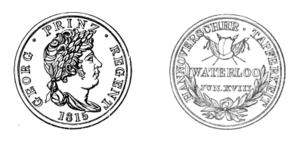Hanoverian Waterloo Medal facts for kids
The Hanoverian Waterloo Medal was a special award given to soldiers from the Hanoverian Army. These brave soldiers fought in the famous battles of Quatre Bras and Waterloo in June 1815. It was a way to honor their courage and service.
Contents
What is the Hanoverian Waterloo Medal?
This medal looks a lot like the British Waterloo Medal. On the front, it shows the side profile of Prince Regent George. He was a very important leader at the time. Around his head, it says "GEORG. PRINZ. REGENT, 1815".
What does the medal look like?
The back of the medal has two laurel branches, which are symbols of victory. There's also a breastplate, which is part of a soldier's armor. Two spears and two flags are crossed behind it. Below, you can see the date "WATERLOO JUN. XVIII." This means June 18th. Above, it proudly says "HANNOVER SCHER TAPFERKEIT" in Roman letters. This means "Hanoverian Bravery."
Who received this special medal?
The medal was created by Prince Regent George in December 1817. It was given to every soldier in the Hanoverian Army who fought at the Battle of Waterloo. The medal hung from a crimson (dark red) ribbon with light blue edges.
Rules for wearing the medal
Unlike in Britain at the time, Hanoverian soldiers were allowed to wear just the ribbon without the medal. This was a special rule for them. Also, the medal belonged to the soldier forever. Even if they left the army, they could still wear it.
The medal could not be given to another soldier. But after the soldier passed away, it was meant to stay with their family. It became a special family treasure. About 16,900 Hanoverian soldiers fought in these battles. They were led by General Charles Alten. These troops made up about 18% of Wellington's entire Allied Army.
Gallery
Famous Recipients
See also
Five different countries created medals for their soldiers who fought in the Waterloo campaign:
- British Waterloo Medal (for British Army and King's German Legion)
- Brunswick Waterloo Medal
- Hanoverian Waterloo Medal
- Nassau Waterloo Medal
- Prussian Waterloo Medal





